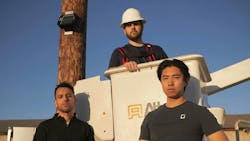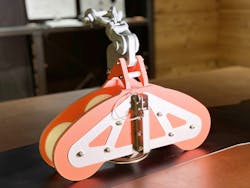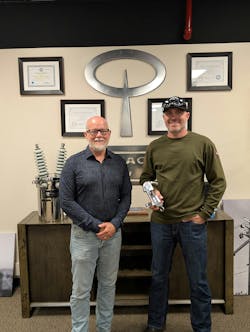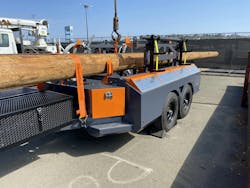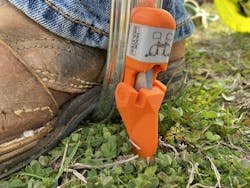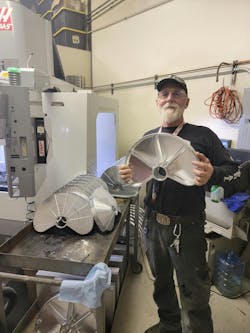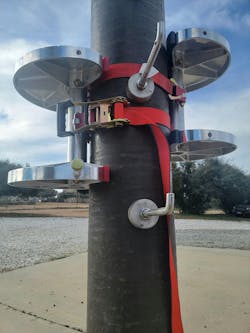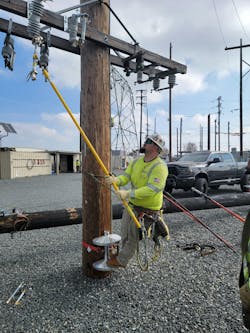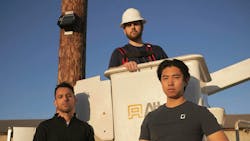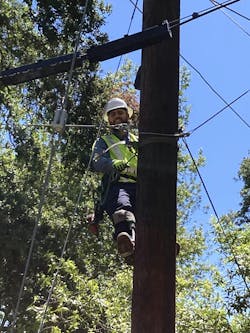Lineworkers Turn Inventors: How Field Innovations Are Improving Safety and Efficiency in the Power Industry
Inspiration for a new invention can strike when lineworkers are climbing a pole, working out of a bucket or even in the middle of the night, when they should be asleep. When they encounter a problem in the field or an obstacle to overcome, they don’t just stand by and wait for someone else to devise a way around the issue — they take it into their own hands and try to make their dream a reality.
“I have been taught that if it were easy, everyone would be doing it,” says Lineworker Rob Seekell about inventing tools for the trade. “I say that if your heart is right, and you have the motivation and knowledge, go for it. I feel anytime anyone brings a tool to our trade that improves safety and production at the same time, it will sell and is a win-win for the industry.”
By bringing the idea swirling around in their heads to the shelves of a local warehouse, they can then help other lineworkers to be safer and more productive so they can come home safely to their loved ones each night.
“Lineworkers are the unseen heroes of the grid,” says Tim Barat, lineworker turned inventor and CEO. “They experience challenges every day, and they have the ability to use their skills and knowledge to innovate and create solutions that can make a difference.”
The following lineworkers didn’t achieve success overnight, but through persistence, dedication and the drive to make a difference, they were able to fill an unmet need in the marketplace. Meet a few inventors and learn how they brought their dreams into reality.
Securing Seven Patents
Seekell, an inventor in Kuna, Idaho, spent 26 years in the field as a lineworker and trainer. He started working around power lines as a line clearance tree trimmer with Asplundh Tree Expert Company. In 1999, he was accepted into the CAL/NEV JATC, and he was on his way to a great career.
Throughout his time in the trade, he worked many ice storm jobs on the northern west coast and fire jobs in southern California. He says when it comes to line work, safety should be top of mind.
“I tell younger apprentices and students when I was training that the right thing is not always the easy or popular thing to do,” he says. “I love this trade and have passion to help our trade be a safer place to work.”
Today he is a remote transmission and distribution inspector, and his home IBEW Local is 291 in Boise, Idaho. He is also the owner of Seekells Innovations LLC, in which he develops lineworker tools that bring safety and efficiency to the trade.
“As a remote inspector, I have worked for Duke Energy and PG&E helping them with their fire mitigation efforts,” he says. “This is a true blessing being home with family and gives me time for my tool developments.”
For example, Seekell holds seven U.S. patents relating to line work and improving the grid. Back in 2017, he noticed many industries were starting to test drones and companies were introducing new advanced conductors into transmission circuits, which inspired him to invent stringing blocks.
“Being an OSHA instructor and T&D certified trainer, I saw the need for a safer, lighter and more efficient stringing block,” he says.
He then designed a stringing block with the first radius shape made of non-conductive materials and aluminum. Lineworkers can mount it to the top side of a pole’s crossarm or remove the pivoting base and hang it with the transmission and distribution models.
When lineworkers are wearing rubber gloves, they no longer need to lock in conductor with use wing nuts or pins. Instead, they can install a base within seconds to a crossarm due to the fast ratchet assembly. Lineworkers can lock the spring-loaded gate in an open position with a hot stick to allow a rope or conductor to be inserted into the block. When the block is energized on the stringing block insulator, the lineworker can transfer the conductor out of the block and stay out of the second point of contact. The radius blocks can also operate as a grounding block with the new grounding assembly that pins to the side of the block.
“It is the first stringing block design for drone stringing technology taking off around the world with a non-conductive fly arm,” he says. “They will also allow new age advanced conductors into our distribution circuits that need a larger bend radius than current blocks.”
Seekell partnered with Meta Design and Manufacturing in Vallejo, California, to produce the blocks. The radius blocks have been improved with a stronger and wider design, and the fourth generation of design will be released. After listening to customers, he also designed three different models — an all-aluminum model, which will only hang for transmission with a high workload limit, and two lightweight Delrin and aluminum models of 10-in and 20-in sizes.
Seekell says Meta is now a licensed manufacturer for all seven of his patented tools including the Seekells Line Lifter (SLL), worm gear support tool, stringing block insulator and Hotline Rotator Tool. Throughout his years in the line trade and his time as an inventor, he says he would not be able to do this alone.
“My time in the trade, products I have invented, my skills and experience, I owe it to God first, family and many good pole buddies,” says Seekell who says to be on the lookout for more tools to come. “I feel so blessed to tell this story and partner with the Meta Design and Manufacturing team. The tools they will be releasing bring safety and efficiency to our great trade.”
Partnering with Lineworkers
James Coleman, owner of Pinnacle Power Services, launched his own design firm, Meta Design Manufacturing, in 2016 in the San Francisco Bay area. After working in the industry for 20 years, he recognized the need for innovation and development. With an engineering background, the U.S. Navy veteran started his own small manufacturing company and patented two personal grounding devices. Along with producing Seekell’s inventions, he also works with other lineworkers to bring their ideas to market.
“It’s all about looking at what the requirements are, why we have done it this way for so long and not doing something about it,” he says. “I love teaming up with lineworkers, who are out in the trenches, are super smart and have some good ideas.”
When lineworkers have an idea for a product, he asks them to present the idea to its industrial design division, who specializes in interviewing and tries to extract what it would look like to take the idea from concept to reality.
“I’ve had guys show pictures of a napkin they sketched out,” he says. “We can use that, but there’s a lot of back and forth with it. I talk to my guys, and if they think it’s a good idea, we keep moving forward and spend the money to build the design and make a prototype to get out in the field. Then we decide if it has a wow factor or not.”
Typically, inventors have visions of making a lot of money, but there’s a high cost to build something and to bring it to market, Coleman says.
“We try to share success with the person who has an idea,” he says. “They need to have the right mindset for innovation because it’s a very stale industry, and there’s room for improvement. Let’s go out and try.”
Coleman’s line construction company is one of the few privately held companies in the service-disabled market in California. He works alongside Gabe Dowdy, a journeyman lineworker and president of the company, to run 23 crews.
Dowdy inspired the invention of the Raptor Clamp, which is designed to go on an overhead line. With the spring mechanism, lineworkers no longer need to use their arm strength to tighten the clamp multiple times on a line.
“We’ve gotten a lot of support from the crews,” Coleman says. “They’re the ones out there getting their arms beat up using the old devices.”
His company also launched two new trailers — one for wildfire response and another one for pole handling and storage. In California, some utility companies are requiring contractors to fit a water tank and a pressurized hose on their trailers, but lineworkers are not experienced firefighters, he says. His new trailer uses a hard hose that is very user-friendly, yet it meets all the specifications and adds value,
To design the new pole trailer, he partnered with lineworkers to completely rethink the design of it and go back to the drawing board. By redesigning it from the ground up, they were able to add new features like framing arms, a work bench and a step. Traditionally, line crews will use an old-style butler trailer, in which they will fasten a crossarm to the side with bolts sticking up to handle the washers, but the new trailer improves safety, especially on the road.
“Pole trailers are empty boxes and pose a danger to the highway,” Coleman says. “We designed it so everything that would go into a tool bin was covered so it wouldn’t fall off and hit a car. We also included a step to get into the trailer because there’s no way to get into the back if you’re getting material, and it takes unnecessary strain to climb in there and climb up and down.”
Safeguarding the Field Workforce
The next lineworker inventor, who wanted to not be named, has worked in the trade for the last 15 years and served his apprenticeship at a municipality in the Midwest. He became interested in the line trade while researching career options in high school.
“I was looking for a hands-on job that would help people, provide a stable income for my family and couldn’t be outsourced,” he says. “I also wanted to be able to enjoy the great outdoors.”
In addition to working as a journeyman lineworker, he also works for Hook Holster. He recently guided products through the design-for-manufacturing process, which he says is no joke.
“You literally have to break the product and remake it in order to make sure all the elements of the product’s form and functionality translate correctly,” he says. “I also make design improvements based on customer feedback and assist in promoting it.”
He says many tools of the trade haven’t evolved much since the 1950s.
“There’s lots of jobs where the tools leave something to be desired or maybe the tool we want doesn’t even exist, but it sparks innovation,” he says. “We tinker, find workarounds or even invent new things. I appreciate how many lineworkers out there have come up with tools that make the work safer and easier for all of us. It’s cool to be a part of that.”
He invented the Hook Holster based on both his personal experience and talking to the lineworkers around him. He realized that the existing gaff guards were easy to break and too easy to lose, whether it was in their bag or out on the job site.
“That means you’ve got sharp spikes in your bag that could tear through your bag, cut some of your equipment or dull your gaffs,” he says. “I’ve even heard multiple stories of people getting cut when they accidentally made contact with their uncovered gaffs, either while reaching into their bag or while carrying the bag to the job site. I wasn’t aware of any ways that linemen were addressing this challenge other than just treating their gaffs as being potentially always uncovered. It was clear to me that a more comprehensive solution needed to be created.”
He called the patent-pending product, “Hook Holster” because lineworkers often call their climbers, “hooks” and you would “holster” something requiring a protective covering when not in use.
“The Hook Holster uses a very simple process: load it onto your gaff, lock it on and it’s ready for storage,” he says. “When you need to climb, simply unlock it off your gaff, unload it with your boot if you want and then secure it onto your ditty bag so it’s ready again when you climb back down.”
Along the way, he made a few key modifications based on customer feedback. For example, he couldn’t decide between blue or orange for the product color, but then he started hearing that it needed to be a high-visibility color to contrast with the blue tarps line crews use at Lineman’s Rodeos. Also, he heard from customers that it needed to be extremely visible, even in low-light conditions, so they added a high-visibility reflective component to the label. He says it’s his goal that the Hook Holster is the most commonly used gaff guard by lineworkers and arborists in the United States and internationally.
“The most common response is, ‘Wow,’ followed by, ‘It’s about time somebody came up with a better way to do this,’” he says.
He says if lineworkers have an idea for an invention, they should stick with it.
“There will be a lot of challenges along the way to developing and launching a new product, but if you really believe in your idea and that it will keep lineworkers safer and make the work easier and better, it’s worth staying committed all the way through. Study the process as much as you can from the patent process to manufacturing to marketing and sales.”
Improving Working Positions on a Pole
Our next inventor, Bruce Thompson, was hooked on the line trade from a young age. When he was just 12 years old, he rode his motorcycle up and down the right of way while his dad was working on a 230 kV transmission line west of Miami. He then spent the lunch hour with different crews and learned how to operate a bucket truck.
“I was just fascinated with helicopters, and I wanted to fly,” Thompson says. “This was the next best thing. I could control this bucket truck and whenever I turned that handle, I could fly around 100 ft in the air. The guys just took to me, and I loved the way they interacted and had a good time. They were just fun to be around.”
In high school, he loved wood shop and metal shop and making and building things, which further cemented his desire to work in the field. When he applied for an apprenticeship, he moved from Florida to Colorado, which was a major change.
“Being born and raised in Florida, I had sand in my shoes,” he says. “When I went to Colorado, that’s the first time I’d ever seen snow.”
After working as a groundman and equipment operator, he spent his apprenticeship all over Colorado and Wyoming, Throughout his career, he worked for three different power companies and dozens of contractors. He also served as a training crew foreman for Southern California Edison (SCE) out of IBEW Local 47, and his crew of apprentices handled work like teardowns, secondary replacements and new line construction. During his 28 years with SCE, he traveled a lot and worked in nearly every district.
After he retired in 2015, he went back to work for contractors in the line trade before earning his engineering A license and C10 high-voltage electrical license. At that point, he was planning on starting his own line construction company, but instead, he became an inventor and the founder of Effective Safety Products. His first invention was the StepUp, which he was inspired to create as a third-step apprentice who climbed for hours at a time in Denver.
“We were doing these property line secondary replacements, and I was the only apprentice on the crew,” he says. “I have really high arches in my feet, and even with good boots, my feet would still hurt. I was thinking, ‘Man, if I could just come up with some small little platform, something to get your foot off that inch-and-a-half stirrup, it would make life a lot easier. So that’s been kicking around in my head for over 40 years.”
On a wood pole, lineworkers can stick their gaffs in their desired position, but on steel or composite poles, they are stuck working off steps in whatever position they happen to be in. This exerts a lot of additional pressure on a lineworker’s feet, legs, and hips causing pain and discomfort. Also, if they’re working on the pole with another lineworker, who is the same height, it can be a nightmare to have four boots, trying to work off of two pole steps.
By using the StepUp, however, lineworkers can get into proper work positioning no matter what type of pole they’re working on. The groundman sends the 23 lb device up on the handline. He holds the weight while the lineworker attaches it to the pole. It takes about 30 seconds to put the StepUp into position, and lineworkers can work on different sides of the same pole. By helping lineworkers to get into a better position on the pole, they can also have longer careers in the field. Thompson should know. After working decades in the field, he’s had surgery to both knees and his shoulders and a stem cell treatment after living with pain.
“Lineworkers should work smarter, not harder,” he says. “You’re out of position the whole time on these composite and steel poles, and that makes you more tired and, in my mind, more susceptible to making a bad decision or injuring yourself.”
To further improve ergonomics, Thompson sloped the back of the platform rather than making it flat and positioning it 90 deg to the pole. That way, when when lineworkers lean back in their belts, their feet are still at a 90 deg angle to their leg.
“It feels like you are standing straight up on flat ground, but you’re up on top of a pole leaning back in your belt, so ergonomically, it is super comfortable,” Thompson says. “When you lean back in your belt now, your knees aren’t being jammed up in your legs and hips. The StepUp allows you to stand in a more upright, more comfortable position. It makes you feel like you’re working in your hooks more than working from the steps.”
The idea first came to fruition when SCE first brought in composite poles. His friend reached out to him to see if there was a way to attach a Baker board to the poles because it was impossible to use the traditional chains. Thompson then spotted two old Baker boards in the trash, and between the two, he made one product that would work, and he retrofitted it to handle a 4-in. ratchet strap and added a coating so it wouldn’t scratch the pole. Even so, it was too heavy.
“I still thought that ‘well, you’re still dealing with this big, awkward, heavy thing,’ and it’s all one guy could carry back into the yard by himself,” he says. “I wanted to come up with something lightweight that lineworkers would use, and they wouldn’t be like, ‘Oh, I don’t want to take the time to put that up.'”
Lineworkers may be reluctant to use it at first, but when they first try it, they’re sold, he says.
“When I do demonstrations, it puts a smile on my face when someone comes up, and I give them my belt and ask them to stand on it,” he says. “It’s almost like a lightbulb above their head goes off, and they go, ‘wow, this is amazing. I can reach anything and everything I need to reach, and I can spin around in my belt.’”
He says one of the things that brings him the most joy is seeing a lineworker get on the StepUp for the first time.
“I relate it to kind of like a new motorcycle,” he says. “You can look at the latest and greatest model, walk around it and even sit on it, but you don’t have a clue what it’s really like until you actually fire it up and take it for a ride.”
Thompson started off making the StepUp in his garage, and he realized very quickly that he couldn’t work full time and build them to the point where others could buy them. When he first started out, he was leveraging his welding experience to make them out of 1-in. pipe.
“That was a practical way to make it, and in reality, it wasn’t because I had 17 pieces for each Step Up that I had to cut and champfer the edges, and it was just so time consuming.”
He then partnered with a local person who has built products for the aerospace industry, but again, it took too much time to manufacture the device. Next, he modified the design of bending it in two halves, welding it together and adding a gusset. After working with a lot of different craftsmen to make just one device, he and his friend decided to try building the entire product on a CNC machine out of four solid pieces of aluminum, so it fits the buckle well and has a strong connection.
“You start off with a solid piece, and you carve out the bottom, then you turn it over, put it back in the machine, and it basically cuts out the design of the top,” he says. “After seeing that, it was so much better than anything I had ever dreamed of.”
He wanted to thank all the other lineworkers for giving him ideas and advice to improve his invention. He says most of the ideas for products in the line trade come from lineworkers, and he’s happy to help others who have an idea on how to improve productivity and safety in the trade.
“It wouldn’t be where it is without all of your collaboration,” he says. “I really appreciate it. From the bottom of my heart, I thank you for all your input.”
One thing he likes most about being an inventor is that he is helping his brothers and sisters in the line trade.
“When they get home after working on the steps, they are beat and worn out,” he says. “When they work off the Step Up, they still have energy to play with their kids, and that makes me feel really good.”
Monitoring for Faults and Wildfires
Another California lineworker turned inventor — Tim Barat — hailed from Victoria, Melbourne, Australia. After dropping out of high school at the age of 15 years old, he became a sparky (electrician) before becoming a liney (lineworker).
Back when he started, there was no such thing as a licensed lineworker in Australia, and he had two pathways to top out — get hired on by a company, do three or four years of coursework and prove himself in the field to be promoted to a liney or take the same coursework and pass three exams to receive an A grade electrician license and become a sparky. Barat opted to become a sparky first and then participate in a three-month electrician-to-lineman program to change from one trade to the other.
“I always knew I wanted to work with power from a young age, but out of high school, I decided to become a sparky first instead of a liney because I was afraid of heights,” he says. “You get over your fear of heights pretty quickly at line school. It’s all in the head. Once you’re doing it every day, it actually almost feels safe. I had jitters at the beginning, but then it just goes away, and it becomes natural. You don’t think about it anymore.”
After three years of working on 240V, however, he got bored, and he decided as soon as he got his A grade license, he would face his fears and do something a little more thrilling.
“I loved being outdoors, and I was excited to be outside more,” Barat says. “The pay as a liney is also better.”
Barat worked as a liney for an Australian utility called Jemena, which serves the greater Melbourne area and the surrounding suburbs. He specialized in construction and maintenance on distribution lines.
“My favorite part about the job was the people, the brotherhood, the guys out in the field,” he says. “No matter what the job calls for, we always had a good time, laughing and teasing each other. I think nothing beats having people come out to thank you when you switch their lights back on after trouble.”
Because the entire population of Australia is the same as the top five cities in the United States combined, lineys must work on a lot of rural lines, and the customers are spread out. He says when you work as a liney in Victoria, the most challenging part of the job is the weather.
“We get four seasons a day, almost every day,” he says. “You have to wear four or five layers and then peel them off as conditions change. You’ll be shivering at breakfast in the rain, and then by lunch, you’ve stripped off all your layers and you’re burning up in the sun, and then by afternoon, you’re back to shivering in the rain again.”
In the United States, severe weather like hurricanes, ice storms and flooding are all too common. In Melbourne, Australia, however, the most dangerous conditions come with high winds.
“When you combine 100 mph wind storms, intense heat and grass growing quickly and drying out with eucalyptus branches and leaves, which produce flammable liquid, it can be very scary,” he says.
Case in point: on Black Saturday in 2009, raging bushfires took the lives of 173 people, injured 414, burned half a million acres, consumed 3500 buildings and killed more than 1 million animals.
“Most lineworkers are generally comfortable with the concept of death,” Barat says. “From day one, we are just getting taught of the different ways we can die, and so we accept that each day may be our last. However, before the fires, I was young, and I was naïve. I always felt like I was invincible, but all that changed after the fires. It was my first real taste of the pain of death, and it kind of changed my view of life forever.”
The fire was a life-defining and career-defining moment for him, and it set him on the career path he is on today. Shortly after the fire, he married his wife, a California native. She encouraged him to leave line work for safety reasons and go back to school to earn his GED and then attend classes at his local community college. He then transferred to the University of California-Berkeley to earn his bachelor’s and master’s degrees in electrical engineering and computer science.
“During the course of my academic career, it became obvious to me that I had a responsibility to leverage my field experience and my newly acquired engineering toolkit to develop technology for the grid,” he says.
At Berkeley, many of his peers were focused on electrical monitoring for the grid, and two gaps quickly emerged for him. The first was the ability to detect impedance faults such as a tree laying on the line.
“We literally don’t know what’s happening when the grid is off,” he says. “Most of the academic and industry research is exclusively focused on electrical monitoring to process voltage and current measurements and detect and locate fault conditions, but this approach appeared flawed to me. The prerequisites to detecting these faults using electrical measurement requires that the fault produce an arc, but as a lineworker, I had seen trees lay into lines or lines come to the ground, and they didn’t produce an arc. During these events, you have current flowing through the tree to ground, and it slowly heats up the tree until it combusts into a fire, or the line electrocutes someone. This is a huge risk.”
He relied on his time in the field to find a solution that was easy to install and operate. When he couldn’t find one, he decided to build his own grid to test technologies.
“Six years ago, after months of research, I wasn’t able to find a single electrical monitoring solution or approach that could reliably detect high-impedance faults,” he says. “Even today, there’s no electrically based monitoring solution that can reliably detect a large tree laying into a line, and this has ignited massive catastrophic fires here in California and throughout the country. It’s baffling to me that these events are some of the highest risks to wildfire ignition and to public safety, yet the utilities have no way to detect them. Without a reliable detection method, the only solution is to switch the power off during dangerous weather conditions.”
After coming up empty-handed on electrical sensing, he decided to build his own full-sized grid with research-grade sensors, 55 ft poles with 200 ft spans, 124 kVA of generation and transformers in Richmond, California. He recorded every single experiment to see if there was another way to detect the events.
“I basically ran a Mythbusters-style grid laboratory,” he says. “I was throwing trees on energized lines, cutting live lines with bolt cutters, exploding transformers and driving cars into poles — literally every fault you can think of, I’ve probably done it on my grid hundreds of times. I guess it’s a lineworker’s dream.”
Through his research, he and his team discovered that the vibration and acoustic signals were unique and clearly above noise during every single trial, and they could even tell the difference between each of the fault conditions based on these signals.
“Then I asked the question, what if I looked at the grid like a giant guitar instead of a circuit board?” he asked. “The lines are strings, the poles are frets, and essentially, you place a guitar pickup on the poles to observe these vibration and acoustic signals that can be felt and heard from the pole during fault conditions and now, since these are mechanical signals, you have visibility during an outage.”
Fast forward to today, and his company, Gridware, which he founded with UC-Berkeley alums, Abdulrahman Bin Omar and Hall Chen, secured a patent for the Gridscope system. The company now has thousands of sensors deployed across the country and works with four of the top 15 largest utilities in the United States. These sensors have accurately identified hundreds of faults like trees on lines, live lines down, animal interactions, malfunctioning equipment and even provided real-time damage assessment during storms when the lines are de-energized.
“So now, utilities can respond to high-impedance fault hazards and pre-stage crews during outages, especially if they’re doing that preventatively,” he says. “We basically solved both of the problems with the technology I had set out to solve.”
The pole-mounted device, called the GridScope, installs faster than a hurtman rescue, is smaller than a pole step and sends information that is simple to understand.
“If you develop a technology that abides by these three principles, it makes it essentially plug-and-play and you can deliver the value immediately to the utility,” he says.
The system processes all the data on a device, and it can help utilities to dispatch crews and equipment to the exact location at the right time, giving them the ability to get power on hours faster. Lineworkers install it halfway up the pole to expedite installation, prevent tampering and ensure safety. The devices are as small as a pole step and as big as a tissue box. Now that it is out on the market, it is constantly evolving. The team iterates through the hardware every two months and the software every two weeks.
“We’re taking real learnings from the field and integrating them into the next design,” he says. “With this architecture, we were able to race through a lot of the challenges and test the system in the real world with utility partners to see if it could survive hailstorms, operate in -20 deg or 120 deg temperatures or in 100 mph winds.
Through the testing, they simplified the installation process. For example, the first version had a bracket, and in the current evolution, it’s just one unit with the brackets above the device, and they provide screws and a drill bit.
“These are just simple things that lineworkers really appreciate,” he says.
They also made sure that it was small so that lineworkers could easily handle and install it in the field.
“When you’re halfway up a pole on hooks and you got one hand on a drill, how are you supposed to hold the device on the pole if it’s not easy to hold with one hand?” he asked. “This is built by lineworkers for lineworkers.”
Lineworkers have a huge opportunity to solve some of the biggest problems on the grid with solutions that are just obvious to lineworkers, he says.
“We always spitball crazy ideas in the field,” Barat says. “My advice is if you have an idea, pursue it. As lineworkers, you have a unique ability to consider practical elements of a solution like ease of install, which makes it much more likely to succeed.”
Tips to Invent a Tool for the Line Trade
- Research what is needed, how to do the job more safely and what would add production without jeopardizing safety.
- Take in-depth notes on each project you do.
- Bounce ideas off everyone on the crew from groundman up, Seekell says. At the same time, Thompson advises lineworkers to keep the idea close to their chest and be mindful of who they share it with.
- Look at different improved materials and advancement of plastic, carbon and aluminum.
- Understand the why, how, who and when and pay attention to what is happing in the power grid and current work methods.
- Develop a prototype and test it in the field.
- Get a good patent attorney and business attorney.
About the Author
Amy Fischbach
Electric Utilities Operations
Amy Fischbach is the Field Editor for T&D World magazine and manages the Electric Utility Operations section. She is the host of the Line Life Podcast, which celebrates the grit, courage and inspirational teamwork of the line trade. She also works on the annual Lineworker Supplement and the Vegetation Management Supplement as well as the Lineman Life and Lineman's Rodeo News enewsletters. Amy also covers events such as the Trees & Utilities conference and the International Lineman's Rodeo. She is the past president of the ASBPE Educational Foundation and ASBPE and earned her bachelor's and master's degrees in journalism from Kansas State University. She can be reached at [email protected].
